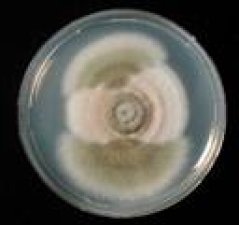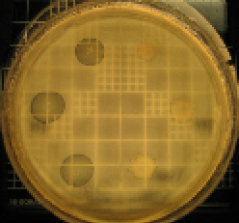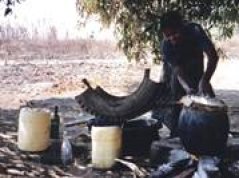Project
Sijmen E. Schoustra - How organisms adapt to novel environments, as single genotypes and as complex communities
How organisms adapt to novel environments, as single genotypes and as complex communities, is one of the key questions in biology and central to my research. In a mix of fundamental and applied projects, my research sheds light on this basic question, and at the same time aims to develop applications addressing problems in society such as the development of indigenous knowledge and the spread of antibiotic resistance. Central themes in my research include evolution of interaction between microbes, the dynamics of adaptation and speciation, the role of sex in evolution and the study of microbial communities within fermented products.
Fitness effects and epistasis of beneficial mutations
Beneficial mutations are the driving force for evolution and have been subject to numerous theoretical studies. Since beneficial mutations are rare, they are difficult to study experimentally. I am using the filamentous fungus Aspergillus nidulans in an environment that reduces its fitness to study beneficial mutations. The spatially structured growth of this fungus on a surface directly reveals the presence of beneficial mutations and allows an experimental study on the distribution of available beneficial mutations versus the distribution of mutations that actually get fixed. Epistasis of beneficial mutations will be measured by combining several spontaneous beneficial mutations into one background.
Microbial ecology of Zambian fermented products: evolution of microbial communities
Analogous to well-known fermented products such as yoghurt, wine, beer and sauerkraut, Zambia has many endogenous fermented products. The fermentation processes are ancient and result in safe products with an increased nutritional value and an increased shelf life than the raw materials. The microbiology of fermentation in these traditional foods is largely unknown and represents an outstanding opportunity for addressing both fundamental and practical questions of wide concern. In particular, why are the microbial communities in these fermented products so stable and what mechanisms prevent the invasion of novel strains such as pathogenic bacteria. These questions represent long-standing issues in community ecology and evolutionary biology, namely, what makes natural microbial communities both diverse and stable over the long-term.
Evolution of antagonistic interactions, the evolution of bacteriocin production by Pseudomonas aeruginosa
Bacteriocins are compounds produced by bacteria and are directed to closely related species. It is known that these compounds have an important ecological function and influence many microbial interactions. Bacteriocins have been suggested as novel antibiotics in medicine. In a survey using 150 clinical isolates of the Pseudomonas aeruginosa, I found that the majority of these isolates can be inhibited by bacteriocin produces by laboratory isolates of P. aeruginosa. This inhibition peaks at intermediate levels of genetic similarity of the producing strain and the targeted strain. In evolutionary experiments, I currently examine to what extent the level of production of these bacteriocins can be a target of selection.

Marie Curie Fellow and Lecturer
Laboratory of GeneticsWageningen University
Phone +31 317 483142
Positions held
- 1999 – 2004: PhD student, Laboratory of Genetics, Wageningen University, the Netherlands (Prof Rolf Hoekstra, Dr Fons Debets)
- 2005: Lecturer, Department of Biological Sciences, University of Zambia
- 2006 – 2010: Postdoctoral fellow, Biology Department, University of Ottawa (Dr Rees Kassen)
- 2010: RDP research fellow, Biology Department, University of Ottawa (with Dr Alexandre Poulain)
- Current: Marie Curie Fellow and Lecturer (toegevoegd docent) Wageningen University, the Netherlands.
Publications
Schoustra, S.E. and D Punzalan. 2012. Correlation of mycelial growth rate with other characters in evolved genotypes of Aspergillus nidulans. Fungal Biology 116: 630-636.
Schoustra, SE, D Punzalan, R Dali, HD Rundle and RK Kassen. 2012. Multivariate phenotypic divergence due to the fixation of beneficial mutations in experimentally evolved lineages of a filamentous fungus. PLoS ONE.
Gifford, DR and SE Schoustra. 2012. Modelling colony population growth in the filamentous fungus Aspergillus nidulans. Journal of Theoretical Biology
Schoustra, S.E., J Dench, R Dali, SD Aaron and RK Kassen. 2012. Antagonistic interactions peak at intermediate genetic similarity. BMC Microbiology 12: 40.
Gifford DR, S.E. Schoustra and RK Kassen. 2011. The length of adaptive walks is insensitive to starting fitness in Aspergillus nidulans. pEvolution 65: 3070-3078.
Meyer JR, S.E. Schoustra, J Lachapelle and RK Kassen. 2011. Boom-bust diversity dynamics in a model adaptive radiation. Proceedings of the Royal Society Series B 278: 392-398.
Schoustra, S.E., H.R. Rundle, R. Dali and R.K. Kassen. 2010. Fitness-associated sexual reproduction in a filamentous fungus. Current Biology 20: 1350–1355.
Dispatch by Cliff Zeyl: Evolutionary Genetics: Desperate Times Call for More Sex. Current Biology. DOI: 10.1016/j.cub.2010.06.008.
Fitzsimmons, J., S.E. Schoustra, J. Kerr, and R.K. Kassen. 2010. Population consequences of mutational events: effects of antibiotic resistance on the r/K trade-off. Evolutionary Ecology 24: 227–236.
Schoustra, S.E., T. Bataillon, D. Gifford, R.K. Kassen. 2009. The properties of adaptive walks in evolving populations of fungus. PLoS Biology, 7: e1000250. Media attention for this publication at the Ottawa Citizen, University of Ottawa/Université d’Ottawa and Jyllands-Posten
Schoustra, S.E., M. Slakhorst, A.J.M. Debets, R.F. Hoekstra. 2007. Mitotic recombination accelerates adaptation in the filamentous fungus Aspergillus nidulans. PLoS Genetics 3 (4): e68.
Schoustra, S.E., M. Slakhorst, R.F. Hoekstra and A.J.M. Debets. 2006. Non-circadian light inducible rhythm in Aspergillus nidulans. Fungal Genetics Newsletter 53: 23-25.
Schoustra, S.E., M. Slakhorst, A.J.M. Debets, R.F. Hoekstra. 2006. Reducing the cost of resistance; experimental evolution in the filamentous fungus Aspergillus nidulans. Journal of Evolutionary Biology 19: 1115-1127.
Schoustra, S.E., M. Slakhorst, A.J.M. Debets, R.F. Hoekstra. 2005. Comparing artificial and natural selection in the rate of adaptation to genetic stress in Aspergillus nidulans. Journal of Evolutionary Biology 18: 771-778.
Schoustra, S.E. 2005. De evolutie van antibioticumresistentie [The evolution of antibiotic resistance]. Gewasbescherming 36: 14-17.
Schoustra, S.E. 2004. Reducing fitness costs associated with antibiotic resistance – experimental evolution in the filamentous fungus Aspergillus nidulans. PhD Thesis Wageningen University. Published by Ponsen & Looijen, Wageningen, ISBN 90-8504-106-6, 144 p.
Schoustra, S.E., A.M. McCollum, K.N. Garner, B.R. Levin. 2004. The population dynamics and ecology of temperate phage: a killing and recruiting allelopath, chapter in PhD thesis, Wageningen University.
Hengeveld A.F., S.E. Schoustra, A.H. Westphal and A. de Kok. 1999. Pyruvate dehydrogenase from Azotobacter vinelandii, properties of the N-terminally truncated enzyme. European Journal of Biochemistry 256: 1-11.
Hartemink R., S.E. Schoustra and F.M. Rombouts. 1999. Degradation of guar gum by intestinal bacteria. Bioscience and Microflora 18: 17-25.
Schoustra, S.E. 1999. De schimmel als fabriek [The fungal factory]. Voedingsmiddelentechnologie 32: 16-18.
Schoustra S.E. (editor). 1999. Food Fermentation. Published by Wageningen University. 194 p.
Schoustra S.E. (editor). 1998. Inleiding in de levensmiddelenmicrobiologie [Food microbiology, an introduction]. Published by Wageningen University. 208 p.


